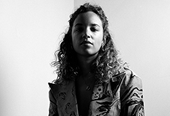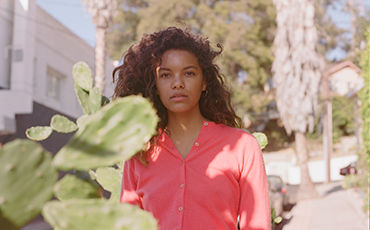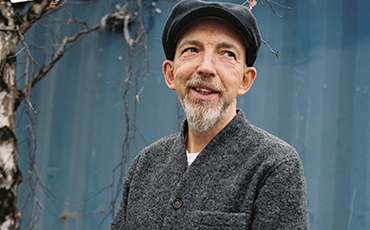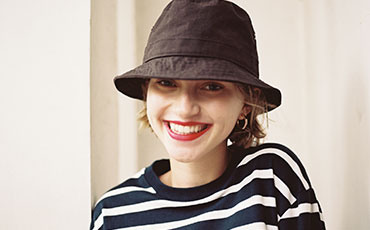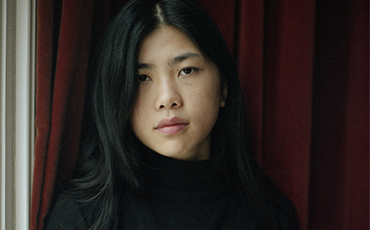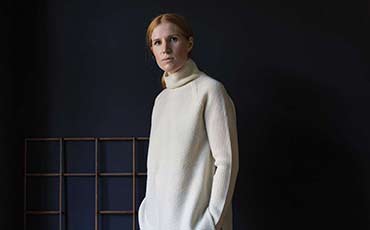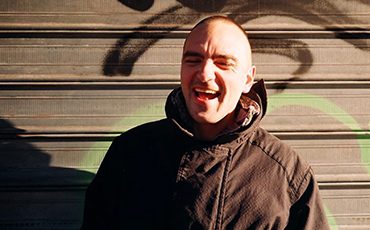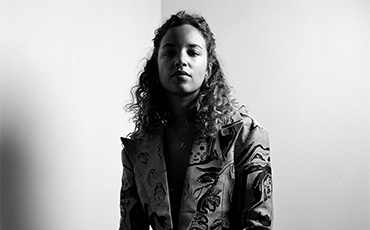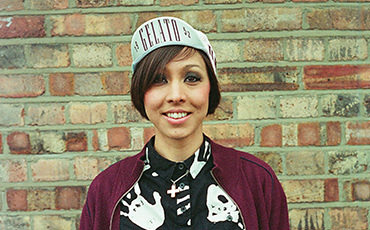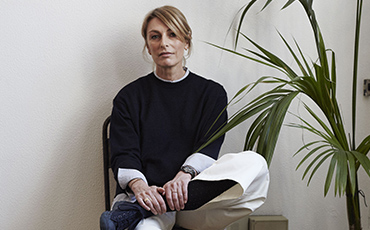01: People
Artist and Subject
When you ask Phoebe Collings-James to tell you about her upbringing in London, she immediately recommends that you to listen to grime MC Kano's Made In The Manor album to get a clear picture. "[He] nods to it a few times in all its complicated, nostalgic glory: the violence of being young there, mixed with the laughs and true friends made," she explains. The 28-year-old artist grew up in Leytonstone in a Jamaican and English household. It was here in her father's dark room that she first learnt the basics of photography and film.
While it is easy to pinpoint where the development of her craft began, Collings-James can't recall her earliest memory of making art. As a child, she was constantly creating because it felt like the most natural thing to her. "I was always naked and making things, so quite like now,"Â she laughs. "I had my little sister Daisy as a loyal assistant and best friend."
During her teenage years, Collings-James embarked down the path of modelling as a way to earn income to support her art. Over time, it has become something that she enjoys doing alongside her artwork. In 2009, Collings-James graduated with a degree in Fine Art. Now she turns to sculpting, painting, and filming installations to express her creativity.
"Art for me is often about translating life, in a way that makes you understand it or appreciate it in a different way,"Â she explains. "When I see a good art work all I wanna do is scream Yasss" The artist has been able to capture something that you could maybe never have put into words so well.
Collings-James makes a concerted effort to collaborate with like-minded people. Often this means not working with galleries that are operated and occupied only by cisgender, white males. A few years back, Collings-James started a blog called Cunt Today as a way to share her research on feminism from a wide range of perspectives. "Looking through the archive now it feels a little naive in places, but I wanted it to absorb the full range of discussions that were being had and not just the ones I agreed with,"Â she says.
Phoebe Collings-James' latest body of work, Just Enough Violence, was recently on display at the CONDO exhibition in London.


[SG] How did your childhood surroundings influence your creativity?
[PCJ] I guess growing up somewhere where soft people spend so much time having to be tough has influenced my work a lot. I think that struggle of the softness of the body and mind in harsh surroundings is something I have been trying to describe or come to terms with. That’s why it’s so interesting now hearing grime music 15 years on. Now, it’s no longer a teenager—grime artists are now in their 30’s and reflecting on their London youth.
Then Dizzee’s Boy In Da Corner came out all those years ago it gave me chills. I never heard a piece of art describe my life so well. I have been trying to build on that feeling ever since. My parents are very open people, hippy cockneys or something so I guess that made me some sort of hybrid wild hippy rude girl. It’s weird, I spent so many years wanting to escape, and now it is somewhere that gives me a lot of comfort to go home to.
[SG] What was your experience like studying Fine Art? Did you enjoy being in that environment? What challenges did you face?
[PCJ] It feels like so many moons ago now! Looking back, I really value that time and the relative freedom I had to learn and develop my work. I loved having a studio for the first time and getting to make work in a fairly critical space. I was one of only two brown kids in my year, my parents were not rich, and I hated hanging around in boring south London pubs, which definitely added to the sense I had of not really fitting in, but the couple of friends I did have and interesting tutors really gave me a lot. The challenge was really in being able to retain a sense of self while engaging with the theories of (almost entirely) dead white guys or white feminist women.
[SG] What is your personal approach to feminism?
[PCJ] My approach to feminism is one of firm support and skepticism. It can so easily be co-opted to suit various suspicious agendas exclusionary to people who are not white, cisgender women. I am just trying to live my own beliefs, which can be hard enough. Believing something and living it are often two quite separate things.
[SG] In our previous interview, you explained that the experience of visiting the Louvre for the first time as a teenager was horrifying. Why was that your reaction?
[PCJ] It seemed so distant from the work I wanted to make and so different from the life I wanted to describe. I hadn’t been exposed to much art up to that point so even though I had an instinct for it, I had no idea really of what it could be.
"The only incorrect part is the "turned". I have always been an artist and in some strange way I have always been a model too."
[SG] Your work tends to evoke a deep sense of emotion. How would you describe your focus?
[PCJ] “Feeling all the feelings all the time.†All good art is emotional, what else do we have but our feelings? Whether it is the physical feeling of hot/cold and hard/soft or the emotions of happy/sad, the binaries teach us how to be. In a world that only values those things when they can be used, it leaves people feeling crazy. Needing to be dosed up. I think I am trying to tap into some of that. Showing work is a way of figuring out ideas, which can be tricky to do in public, especially if the ideas fail somehow.
[SG] What other projects have you been working on?
[PCJ] I am in the process of creating a series of mystical narrative paintings on paper. I’m excited about it as it kind of feels like it’s been building up for some time. I have always made films that are one shot, drawings of single figures, paintings with single gestures and movements. Creating a narrative has been something I’ve had bubbling up in my imagination, but not been able to articulate. These new panels are going to be a culmination of all of these collective symbols, creatures, and ideas.
I think the need to tell stories even if they are sort of mystical is a really ancient way of dealing with the main theme that has developed in my work, that of communication. People have always used stories to communicate the past, present and future. It’s an old-school device, but I am hoping it will help me communicate some of the thoughts in my work.
This past year, I think my third eye has been really tuning in a lot more and receiving the world in a way that is making me feel a bit electrically charged. I’ve been trying to listen to it; I guess it’s about connecting to the truth of your instincts. I’ve been listening to music more like I did when I was younger, which I think helps you connect with non-verbal energy. Maybe I sound crazy, and it does feel a bit like that too, but I think it’s still real.
I went to see this amazing performance in New York last month called “Black Rage†performed by Richard Kennedy, which was already so powerful, and at the end as people were leaving they played Stevie Wonder’s Inversions record. I have been listening to it everyday since—the artwork with the third eye shining like a pyramid was the final connection I needed to sort of link all the ideas I’d been having in the studio.
[SG] Does it bother you when you are categorized as a “model-turned-artist� Has fashion altered your perspective of art in any way?
[PCJ] The only incorrect part is the “turned.†I have always been an artist and in some strange way I have always been a model too. In the sense that I have always been referred to as “beautiful†in a way that implied I was a peculiar object and had very little to do with me as a person.
When I was 14, I got my sister to take photos of me that I sent to Storm Modeling Agency in London with my measurements, behind my parents back. It had nothing to do with vanity, I was just a little hustler. I was acutely aware of myself as subject and object and knew that I could potentially make lots more money than I was getting at my hairdressing job washing out old ladies’ smelly perms. They wrote back and after much persuading my mum let me sign with them. It opened up a whole new world for me.It allows me to express a part of myself that enjoys performing, using my body, showing off. So then when I am being my other self, an artist—which is most of the time—I can be a solitary, shy geek. We can all have many sides, but mostly society is so fearfully boring we are forced to stay in one box.




[SG] As an artist, do you find yourself naturally gravitating toward creative people? Do you have any muses in your personal life?
[PCJ] Definitely, but they don’t all do it in the way I do which is even better. They might be musicians or designers or not even do it as a job—they just have wild imaginations, which is always inspiring. My sweetheart and close friends are a constant source of love and inspiration. My oldest friend Jamila Johnson-Small is a choreographer; she is the one I can really do shorthand with when I am bouncing around ideas.
I get constant inspiration from the work of artist Jesse Darling; our ideas seem to often be really in synch. The other day, we realized we were both thinking about Batman a lot—what he represents as a figure who is a normal guy born with no superpowers who tries to save a world that wants to destroy him. That loops back to Boy In Da Corner, looking back at that cover artwork, the hoodie is very batman—especially with the fingers up as horns/ears. Head down, heart on sleeve.


